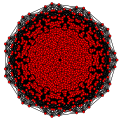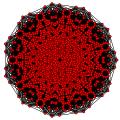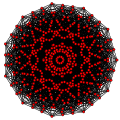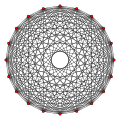| # | Graph | Coxeter-Dynkin diagram
Schläfli symbol
Name | Element counts |
|---|
| 9-faces | 8-faces | 7-faces | 6-faces | 5-faces | 4-faces | Cells | Faces | Edges | Vertices |
|
| 1 |  |                   
t0{3,3,3,3,3,3,3,3,3}
10-simplex (ux)
| 11 | 55 | 165 | 330 | 462 | 462 | 330 | 165 | 55 | 11 |
|---|
| 2 |  |                   
t1{3,3,3,3,3,3,3,3,3}
Rectified 10-simplex (ru)
| | | | | | | | | 495 | 55 |
|---|
| 3 |  |                   
t2{3,3,3,3,3,3,3,3,3}
Birectified 10-simplex (bru)
| | | | | | | | | 1980 | 165 |
|---|
| 4 |  |                   
t3{3,3,3,3,3,3,3,3,3}
Trirectified 10-simplex (tru)
| | | | | | | | | 4620 | 330 |
|---|
| 5 |  |                   
t4{3,3,3,3,3,3,3,3,3}
Quadrirectified 10-simplex (teru)
| | | | | | | | | 6930 | 462 |
|---|
| 6 |  |                   
t0,1{3,3,3,3,3,3,3,3,3}
Truncated 10-simplex (tu)
| | | | | | | | | 550 | 110 |
|---|
| 7 |  |                   
t0,2{3,3,3,3,3,3,3,3,3}
Cantellated 10-simplex
| | | | | | | | | 4455 | 495 |
|---|
| 8 |  |                   
t1,2{3,3,3,3,3,3,3,3,3}
Bitruncated 10-simplex
| | | | | | | | | 2475 | 495 |
|---|
| 9 |  |                   
t0,3{3,3,3,3,3,3,3,3,3}
Runcinated 10-simplex
| | | | | | | | | 15840 | 1320 |
|---|
| 10 |  |                   
t1,3{3,3,3,3,3,3,3,3,3}
Bicantellated 10-simplex
| | | | | | | | | 17820 | 1980 |
|---|
| 11 |  |                   
t2,3{3,3,3,3,3,3,3,3,3}
Tritruncated 10-simplex
| | | | | | | | | 6600 | 1320 |
|---|
| 12 |  |                   
t0,4{3,3,3,3,3,3,3,3,3}
Stericated 10-simplex
| | | | | | | | | 32340 | 2310 |
|---|
| 13 |  |                   
t1,4{3,3,3,3,3,3,3,3,3}
Biruncinated 10-simplex
| | | | | | | | | 55440 | 4620 |
|---|
| 14 |  |                   
t2,4{3,3,3,3,3,3,3,3,3}
Tricantellated 10-simplex
| | | | | | | | | 41580 | 4620 |
|---|
| 15 | |                   
t3,4{3,3,3,3,3,3,3,3,3}
Quadritruncated 10-simplex
| | | | | | | | | 11550 | 2310 |
|---|
| 16 |  |                   
t0,5{3,3,3,3,3,3,3,3,3}
Pentellated 10-simplex
| | | | | | | | | 41580 | 2772 |
|---|
| 17 | |                   
t1,5{3,3,3,3,3,3,3,3,3}
Bistericated 10-simplex
| | | | | | | | | 97020 | 6930 |
|---|
| 18 | |                   
t2,5{3,3,3,3,3,3,3,3,3}
Triruncinated 10-simplex
| | | | | | | | | 110880 | 9240 |
|---|
| 19 |  |                   
t3,5{3,3,3,3,3,3,3,3,3}
Quadricantellated 10-simplex
| | | | | | | | | 62370 | 6930 |
|---|
| 20 | |                   
t4,5{3,3,3,3,3,3,3,3,3}
Quintitruncated 10-simplex
| | | | | | | | | 13860 | 2772 |
|---|
| 21 |  |                   
t0,6{3,3,3,3,3,3,3,3,3}
Hexicated 10-simplex
| | | | | | | | | 34650 | 2310 |
|---|
| 22 | |                   
t1,6{3,3,3,3,3,3,3,3,3}
Bipentellated 10-simplex
| | | | | | | | | 103950 | 6930 |
|---|
| 23 | |                   
t2,6{3,3,3,3,3,3,3,3,3}
Tristericated 10-simplex
| | | | | | | | | 161700 | 11550 |
|---|
| 24 | |                   
t3,6{3,3,3,3,3,3,3,3,3}
Quadriruncinated 10-simplex
| | | | | | | | | 138600 | 11550 |
|---|
| 25 |  |                   
t0,7{3,3,3,3,3,3,3,3,3}
Heptellated 10-simplex
| | | | | | | | | 18480 | 1320 |
|---|
| 26 | |                   
t1,7{3,3,3,3,3,3,3,3,3}
Bihexicated 10-simplex
| | | | | | | | | 69300 | 4620 |
|---|
| 27 | |                   
t2,7{3,3,3,3,3,3,3,3,3}
Tripentellated 10-simplex
| | | | | | | | | 138600 | 9240 |
|---|
| 28 |  |                   
t0,8{3,3,3,3,3,3,3,3,3}
Octellated 10-simplex
| | | | | | | | | 5940 | 495 |
|---|
| 29 | |                   
t1,8{3,3,3,3,3,3,3,3,3}
Biheptellated 10-simplex
| | | | | | | | | 27720 | 1980 |
|---|
| 30 |  |                   
t0,9{3,3,3,3,3,3,3,3,3}
Ennecated 10-simplex
| | | | | | | | | 990 | 110 |
|---|
| 31 | |                   
t0,1,2,3,4,5,6,7,8,9{3,3,3,3,3,3,3,3,3}
Omnitruncated 10-simplex | | | | | | | | | 199584000 | 39916800 |
|---|




























































